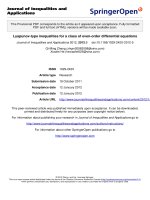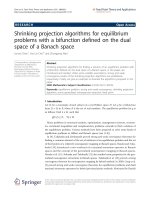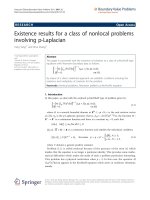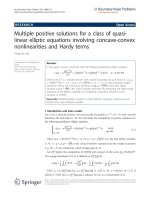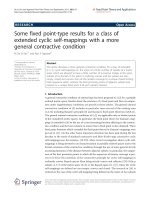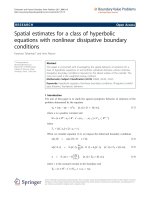exponential attractors for a class of reaction difusion problems with time delay
Bạn đang xem bản rút gọn của tài liệu. Xem và tải ngay bản đầy đủ của tài liệu tại đây (174.25 KB, 19 trang )
J.evol.equ. 7 (2007), 649–667
© 2007 Birkh¨auser Verlag, Basel
1424-3199/07/040649-19, published online August 09, 2007
DOI 10.1007/s00028-007-0326-7
Exponential attractors for a class of reaction-diffusion problems with
time delays
´
Maurizio Grasselli and Dalibor Praˇzak
Abstract. We consider a reaction-diffusion system subject to homogeneous Neumann boundary conditions on a
given bounded domain. The reaction term depends on the population densities as well as on their past histories in
a very general way. This class of systems is widely used in population dynamics modelling. Due to its generality,
the longtime behavior of the solutions can display a certain complexity. Here we prove a qualitative result which
can be considered as a common denominator of a large family of specific models. More precisely, we demonstrate
the existence of an exponential attractor, provided that a bounded invariant region exists and the past history decays
exponentially fast. This result will be achieved by means of a suitable adaptation of the -trajectory method coming
back to the seminal paper of M´alek and Neˇcas.
1. Introduction
A large number of mathematical models in population dynamics have the following form
(see, e.g., [1, 2, 3, 12, 18, 19, 20, 21, 26, 37, 38, 42, 43, 44, 45] and references therein)
u, u t ),
∂t u − D u = F (u
in
× (0, ∞) ,
(1.1)
where is a bounded, open and connected subset of R , h ∈ N. Here u = (u1 , . . . , uM ) :
× R → [0, ∞)M represents the population density vector and D = diag[d1 , . . . , dM ]
is a diffusion matrix (di > 0, i = 1, . . . , M). Moreover, F is a reaction function which
depends not only on u (x, t), but also includes a general functional dependence on the past
history up to t, denoted by
h
u t (·, s) = u (·, t + s), s ∈ (−∞, 0] .
(1.2)
We suppose that the populations are isolated, so that system (1.1) is subject to the
Neumann homogeneous boundary conditions
∂nu = 0,
on ∂
× (0, ∞) .
(1.3)
Mathematics Subject Classifications (2000): 35B41, 45K05, 92D25.
Key words: Reaction-diffusion equations, nonlocal effects, invariant regions, -trajectory method, exponential
attractors.
The first author was partially supported by the Italian PRIN 2006 research project Problemi a frontiera libera,
ˇ 0021620839
transizioni di fase e modelli di isteresi. The second author was supported by the research project MSM
and by the project LC06052 (Jindˇrich Neˇcas Center for Mathematical Modeling).
650
´
M. Grasselli and D. Praˇzak
J.evol.equ.
In addition, in view of (1.2), the initial datum is the past history up to t = 0, i.e.,
u 0 = η,
in
× (−∞, 0] .
(1.4)
Among the main goals in the investigation of such kind of systems there are, in particular,
the stability of the equilibria and the existence of (stable) periodic solutions. However, if M
is very large even the determination of the equilibria might be an extremely difficult task.
Therefore, dealing with very general situations, it seems convenient to interpret the model
as a dissipative dynamical system in a suitable phase space, trying to prove the existence of
sufficiently small (i.e., finite fractal dimensional) compact invariant sets which characterize
the longtime dynamics of the model itself. Typical mathematical objects possessing the
mentioned features are the global attractor (see, e.g., [9, 23, 40]) and the exponential attractor
(cf. [13, 14, 15]). It is also worth seeing [31] for an updated review of such notions.
The key step of such an analysis is a suitable choice of the underlying phase space (cf. the
pioneering contribution [24]). One possibility is to introduce a new variable, the so-called
summed past history, which accounts for the memory effects, and obeys certain first order
dissipative equation (see [22], or [6, 7] for equations like (1.1)). This approach is useful
when one wants to analyze the stability of the attractor with respect to certain parameters
of the given system (e.g., in [6], the relaxation times). The limitation of the summed past
history approach is that the delay has to be described in terms of a convolution with rather
restricted class of kernels.
Another approach is the construction of the so-called trajectory attractor (see [9], cf. also
[8].) Here the phase space consists of negative semi-trajectories and the dynamical system
is defined by means of a translation semigroup. Note that this is a natural setting for the
problems with delay, and no additional variables are needed. A detailed comparison of the
past history approach and the concept of trajectory attractor is given in [8]. It turns out that
if both methods are applicable, they are equivalent regarding the notion of global attractors,
but the advantages of the former stand out.
Nonetheless, there are models to which the past history approach does not apply, while
the trajectory one does. For instance, in the case of discrete state-dependent delays, a
recent result about the existence of the global trajectory attractor is proven in [36] (see also
references therein). There the author also treats the case of distributed (but finite) delays by
means of a more conventional approach which regards the delays as additional variables.
In the case of infinite delays, a meaningful example can be easily given by exploiting the
generality of (1.1). Indeed, hereditary effects can be modelled, for instance, as follows
(see, e.g., [39])
0
u(t + s), s)ds .
K(u
−∞
In the present paper, we want to cover such general classes of models; hence the summed
past history approach is not applicable. As a phase space, we take the set of the histories η,
Vol. 7, 2007
Reaction-diffusion problems with time delays
651
defined on (−∞, 0]. An additional requirement is that η solves (1.1) on [− , 0], where
> 0 is some fixed number. This has certain similarity to the trajectory approach discussed
above, but also goes back to the ideas of [28], see also [29] or [34], where a similar approach
was applied to the class of problems with bounded delay. The main advantage of such a
choice is that the phase space can be endowed with a more convenient L2 -norm rather then
the L∞ -norm; see also the discussion below Theorem 1.1. In particular, we easily establish
the smoothing property of the dynamics, yielding the existence of an exponential attractor.
The main requirement of our analysis is the existence of a bounded invariant region.
This is a natural assumption for the reaction-diffusion systems (without delay), and has
been used by many authors; see e.g. [5, 10, 11, 30]. However, in presence of delays, things
become more delicate. As shown in [16, 27], the simple problem
∂t u(x, t) − µ u(x, t) = u(x, t) 1 − u(x, t − τ )
admits solutions that grow exponentially, despite a natural sign condition of the right-hand
side. Nonetheless, there are numerous models governed by systems of type (1.1), for which
the invariant regions exist (cf., for instance, [6, 7, 19, 32, 33, 37, 38, 39, 42, 43, 44, 45]).
Some meaningful examples are considered in the last section.
To be more specific, we assume that there exist ai ≥ 0 and bi > 0, i = 1, . . . , M, such
that, setting I = M
for any s ∈ (−∞, 0], then
i=1 [ai , bi ], if η ∈ I almost everywhere in
u(x, t) ∈ I for t ≥ 0 as well. Here u is a suitable concept of solution, defined on a maximal
time interval [0, Tmax ). The immediate consequence is that Tmax = +∞, and, trivially, the
asymptotic boundedness of the dynamics.
At our abstract level of presentation, we will assume that there exists a closed, bounded
set K ⊂ L2 ( ; RM ), such that, if η ∈ C((−∞, 0]; K), then u(·, t) ∈ K for all t ≥ 0. In
concrete examples, however, one always has
K = v ∈ L2 ( ; RM ) : v (x) ∈ I, a.e. x ∈
,
thus the solutions are even uniformly bounded. As a phase space of our problem, we choose
B = C((−∞, 0]; K) .
Before introducing a metric in B, we first indicate by · 2 the standard norm in L2 ( ; RM )
induced by the natural scalar product (·, ·), and then we state the basic assumption on F ,
namely,
there exist
> 0 and γ > 0 such that
F (u
u1 , η1 ) − F (u
u2 , η2 )
2
2
≤
u1 − u2
0
2
2
+
−∞
η1 (s) − η2 (s)
2 γs
2e
ds ,
(1.5)
652
J.evol.equ.
´
M. Grasselli and D. Praˇzak
for any u 1 , u 2 ∈ K and η1 , η2 ∈ B. Observe that, the only requirement on the past history
dependence is the exponential decay. This generality allows us to consider a wide class of
memory kernels in concrete cases (see, e.g., Section 6, compare also with [12]).
We can now endow B with the norm given by
0
η
2
X
=
η(s)
2 γs
2e
(1.6)
ds ,
−∞
where γ > 0 is the same as in (1.5). Observe that B is not complete (in fact it is not closed)
with respect to the X-norm.
The basic existence result we need is the following.
THEOREM 1.1. Let (1.5) hold. For any given η ∈ B and any fixed T > 0, there exists
a unique u solution to (1.1), (1.3), (1.4) on [0, T ] such that
u ∈ C((−∞, T ]; L2 ( ; RM )) ∩ L2 (0, T ; W 1,2 ( ; RM )),
∂t u ∈ L2 (0, T ; (W 1,2 ( ; RM ))∗ ).
(1.7)
Moreover, u (t) ∈ K for all t ∈ [0, T ] and there exists K0 > 0, independent of T , such that,
for any fixed r ∈ (0, T ),
t+r
∂t u
sup
t∈[0,T −r] t
2
−1,2
+ u
2
1,2
≤ K0 .
(1.8)
Proof. Using the Lipschitz continuity in (1.5), it is easy to construct u on some small
interval [0, T0 ], via the standard fixed point argument. Note that, since u(t) ∈ K for all
t ∈ (−∞, T0 ], it follows that
T0
∂t u
0
2
−1,2
+ u
2
1,2
≤K.
Observe that K and T0 only depend on K and the constants in (1.5), but are independent of
η = u |(−∞,0] . This fact allows us to repeat the argument on the time interval [T0 , 2T0 ] and
so on, reaching eventually the given time T . Uniqueness follows by the usual Gronwall-type
argument (see Lemma 3.2 below).
As a consequence, we can now define a solution operator S(t) : B → B by S(t)η = u t ,
where u is given by the previous theorem (recall the notation (1.2).) Our aim is to construct
an exponential attractor for a suitable interpretation of the dynamical system (S(t), B).
Problem (1.1), (1.3), (1.4) has a unique solution for any initial datum in B. However,
note that we do not have continuity of the solution with respect to the X-norm of the initial
datum (compare with [6, 7]). One would need to use the sup-norm of B, which, however,
Vol. 7, 2007
Reaction-diffusion problems with time delays
653
is much less convenient for the further analysis. To circumwent this difficulty, we follow
the -trajectory approach (see [28, 29]), and set
B− = S( )B ,
where > 0 is an arbitrary fixed number. Simply said, B− consists of those elements
of B that are solutions on [− , 0]. Obviously S(t)B− ⊂ B− for all t ≥ 0. From the
point of view of the large time dynamics it is irrelevant if we restrict our study to B− .
The advantage is that S(t) is Lipschitz continuous on B− with respect to the norm X,
as we shall prove below (see Lemma 3.2). Note that also B− is not complete (even less
compact) in X, but we will show that it is asymptotically compact. This is enough to apply
the standard tools from the theory of attractors.
REMARK 1.2. By the same scheme one can cover the more general case where there
are also discrete delays (see, e.g., [32]), i.e.,
u(t), u (t − τ1 ), . . . , u (t − τk ), u t ),
∂t u − D u = F (u
with some τi > 0. Moreover, the linear diffusion operator might also be replaced by a nonu) satisfying appropriate assumptions.
linear elliptic operator in divergence form − ∇· A (∇u
2. Preliminaries from the theory of attractors
Let X be a bounded metric space. By Nχ (A, ρ) we denote the smallest number of sets
with diameter ≤ 2ρ that cover A ⊂ X . The fractal dimension is defined by
f
dX (A) = lim sup
ε→0+
ln Nχ (A, ε)
.
− ln ε
Let (t) : X → X be a continuous semigroup of operators. For the reader’s convenience, we recall that A ⊂ X is called a global attractor for ( (t), X ) if
(1) A is compact;
(2) (t)A = A, ∀t > 0;
B , A) → 0 as t → ∞, for any B ⊂ X bounded.
(3) distX ( (t)B
Of course, if a global attractor exists, then it is unique. The set E ⊂ X is called exponential
attractor if
(1)
(2)
(3)
(4)
E is compact;
(t)E ⊂ E, ∀t > 0;
f
dX (E) < ∞;
B , E) ≤ C(B
B ) e−σ t .
∃ σ > 0 such that, for any B ⊂ X bounded, distX ( (t)B
654
J.evol.equ.
´
M. Grasselli and D. Praˇzak
It is customary to work in a setting where the underlying phase space X is either compact
or, at least, complete space (typically, a closed subset of a Banach space with some higher
regularity). In the present case it is convenient to relax this assumption to the asymptotic
compactness, see the definition in Theorem 2.1 here below.
The construction of an exponential attractor is based on several ideas that are nowadays
well-known and widely used in the literature. Because our setting is somewhat unusual (the
phase space is not complete), we present the following theorem with the proof.
The key step of the construction normally consists in certain squeezing or smoothing
property of the semigroup (see, e.g., [13, 14, 15]). To keep the things simple for now, we
replace it by a more abstract “iterated covering property” – see (2.3) below – which will
later be deduced from the smoothing property in the spirit of [15] (cf. Lemma 5.1 below).
Remark also that (2.3) is only slightly stronger that (2.4). Also, we recall that the latter
property is equivalent to the existence of an exponential attractor in the discrete case (see
[35]).
THEOREM 2.1. Let X be a bounded metric space, and
semigroup. We assume:
(t) : X → X be a continuous
(1) asymptotic compactness: for arbitrary sequences {ηn } ⊂ X and tn → ∞, there is
a subsequence (not relabeled) {ηn } and η0 ∈ X such that (tn )ηn → η0 .
(2) continuity: for all η, η˜ ∈ X and t,t˜ ∈ [0, T ]
˜ ≤ c distX (η, η)
˜ ,
distX ( (t)η, (t)η)
(2.1)
distX ( (t)η, (t˜)η) ≤ c|t − t˜| ,
(2.2)
a
with some a ∈ (0, 1].
(3) iterated covering property: there exist N ≥ 1, θ ∈ (0, 1) and t ∗ > 0 such that, for
any B ⊂ X with diamX B ≤ 2ρ, one has
Nχ ( (t ∗ )B, θρ) ≤ N .
(2.3)
Then there exists an exponential attractor E for ( (t), X ) and the following estimate holds
f
dX (E) ≤
1
a
ln N
+1 .
− ln θ
Proof. We split the argument into two main steps.
I. We begin with an exponential attractor E ∗ for the discrete dynamical system ( n , X ),
where
= (t ∗ ). Pick ρ > 0 such that diam X ≤ 2ρ. Applying (2.3) repeatedly, we
arrive at
Nχ (
n
X , θ n ρ) ≤ N n ,
∀n ∈ N .
(2.4)
Vol. 7, 2007
Reaction-diffusion problems with time delays
655
This implies the existence of E ∗ – an exponential attractor for ( n , X ) – together with the
estimate (see [35, Theorem 1])
ln N
f
dX (E ∗ ) ≤
.
(2.5)
− ln θ
A certain care is needed, since we assume that X is neither compact nor complete. However,
asymptotic compactness is enough for the existence of a global compact attractor A, which
is defined as the ω-limit set of X . The exponential attractor is constructed as
E∗ = A ∪
m
En ,
m,n≥0
where En is a finite subset of n X such that distX ( n X , En ) ≤ 2θ n ρ. The existence of
En s is guaranteed by (2.4). The double union is not compact, but thanks to the asymptotic
compactness, any sequence that intersects infinitely many En s has an accumulation point
in A. Hence E ∗ is compact.
II. We define F : X × [0, ∞) → X by F(η, t) = (t)η. F is a-H¨older continuous by
(2.1)–(2.2), from which one deduces that E = F(E ∗ × [0, t ∗ ]) is the desired exponential
attractor for ( (t), X ). Regarding the dimension estimate, one has
f
dX (E) ≤
ln N
+1 .
− ln θ
1
1 f
dX ×[0,∞) (E ∗ × [0, t ∗ ]) ≤
a
a
3. Continuity and the smoothing property
We start with some simple estimates about the continuity of the time shift. Recall the
convention (1.2).
LEMMA 3.1. Let u : R → L2 ( ; RM ) be a measurable function. Then
ut
ut
0
u
t
2
X
≤ e−γ t u 0
2
X
≤ e−γ t u 0
2
2
≤ e−γ t u 0
2
X
, ∀t ≤ 0 ,
t
2
X
+
2
X
, ∀t ≤ 0 .
u
0
(3.1)
2
2,
∀t ≥ 0 ,
(3.3)
Proof. One has
0
u t 2X
=
u (t + s)
2 γs
2e
ds =
−∞
= e−γ t
t
−∞
u (τ )
2 γτ
2e
dτ .
t
−∞
(3.2)
u (τ )
2 γ (τ −t)
dτ
2e
656
J.evol.equ.
´
M. Grasselli and D. Praˇzak
Hence (3.1) follows, while for t ≥ 0 one writes
2
X
ut
0
= e−γ t
u (τ )
−∞
≤ e−γ t u 0
2
X
t
+
t
dτ +
2 γτ
2e
2 γ (τ −t)
dτ
2e
u (τ )
0
u (τ ) 22 dτ .
0
Similarly one proves (3.3).
The following lemma is a standard estimate of the difference of solutions, but it has
important consequences: the continuity of S(t) as well as the smoothing property, which is
the key step toward the existence of an exponential attractor.
LEMMA 3.2. Let u , v be solutions on [− , T ] corresponding to initial data η, η˜ in B− .
Then w = u − v satisfies
sup
w (t)
t∈[0,T ]
2
2
T
+ d0
2
1,2
w
0
≤ CT η − η˜
2
X
(3.4)
,
where d0 = mini=1,...,M di and CT > 0 depends on T .
Proof. Testing the equation written for w by w gives
M
∂t w
2
2
+
di ∇w i
2
2
F (u
u, u t ) − F (vv , v t ), w ) .
= (F
i=1
Using (1.5) and adding d0 w
2
2
∂t w (t)
2
2
to both sides give
+ d0 w (t)
2
1,2
≤c
w (t)
2
2
+ wt
2
X
∀t ∈ [− , T ] .
,
Note that, from now on, the constant c may change from line to line. We fix s ∈ [− , 0],
τ ∈ [0, T ] and integrate on (s, τ ) to get
w (τ )
2
2
τ
+ d0
w
s
2
1,2
≤ w (s)
2
2
τ
+c
w
s
2
2
τ
+
wt
s
2
X
dt
2
2
.
Using (3.1) and (3.2), we deduce
τ
w
s
2
2
τ
+
wt
s
2
X
dt ≤ c
w0
2
X
τ
+
w
0
2
2
.
Hence
w (τ )
2
2
τ
+ d0
w
0
2
1,2
≤ w (s)
2
2
+c
w0
2
X
τ
+
w
0
.
Vol. 7, 2007
Reaction-diffusion problems with time delays
657
Integrating over s ∈ (− , 0) and using (3.3) eventually yields
w (τ )
2
2
τ
+ d0
w
0
2
1,2
≤c
η − η˜
2
X
τ
+
w
0
2
2
.
Since τ ∈ [0, T ] is arbitrary, we have the conclusion from the Gronwall lemma.
Recalling (3.2), we have, as immediate corollary,
S(t)η − S(t)η˜
X
≤ CT η − η˜
X
, ∀t ∈ [0, T ], ∀η, η˜ ∈ B− ,
(3.5)
i.e., the local Lipschitz continuity of solution operators. Note that CT grows at most
exponentially with respect to T .
A second important by-product of Lemma 3.2 is
T
1/2
w
2
1,2
≤ CT η − η˜
X
(3.6)
.
0
In fact, we can now follow the idea of [28] (see also [29]) to employ the last estimate
to obtain a smoothing property of the flow in the space of L2 (0, T ; L2 ( ; RM )). This
is based on the compactness from the well-known Aubin-Lions lemma. Thus we need a
similar estimate for the time derivative.
LEMMA 3.3. Let u , v be solutions on [− , T ] corresponding to initial data η, η˜ in B− .
Then there holds
T
1/2
∂t w
2
−1,2
≤ CT η − η˜
X
.
(3.7)
0
Proof. The left-hand side of (3.7) equals to
T
sup
ϕ∈B1 (0)
∂t w , ϕ ,
0
where ·, · is the duality between W 1,2 ( ; RM ) and (W 1,2 ( ; RM ))∗ , while B1 (0) is the
unit ball of L2 (0, T ; W 1,2 ( ; RM )) centered at 0.
From the equation for w we have
T
T
∂t w , ϕ = −a
0
T
(∇w
w , ∇ϕ) +
0
= I1 + I2 .
F (u
u, u t ) − F (vv , v t ), w )
(F
0
658
J.evol.equ.
´
M. Grasselli and D. Praˇzak
By (3.6) and the H¨older inequality, it follows
T
|I1 | ≤ c
w
1,2
ϕ
1,2
≤
0
1/2
T
w
2
1,2
≤ CT η − η˜
X
.
0
An analogous estimate holds for I2 , in virtue of (1.5) and (3.4).
4. Asymptotic smoothness and compactness
In order to construct an exponential attractor, we need to restrict ourselves to a smoother
subset of B− . In particular, we need more regularity with respect to time. An interesting
feature of the -trajectory approach is that the regularity of weak solutions (1.7) is enough.
Due to the hyperbolic nature of our problem, sets of higher regularity cannot be absorbing.
Instead we prove the existence of smooth sets which are exponentially attracting (compare
with [7]).
LEMMA 4.1. There exists B1 ⊂ B− with the following properties:
(1) S(t)B1 ⊂ B1 for ∀t > 0;
(2) there exists K1 > 0 such that
t
∂t η
sup
t≤0
t−1
2
−1,2
+ η
≤ K1 ,
2
1,2
∀η ∈ B1 ;
(4.1)
(3) B1 attracts B− exponentially fast.
Proof. Let η ∈ B− be arbitrary and fix T ≥ 1. Denote by u the solution on [0, T ] with
u 0 = η. Thanks to (1.8) we have
t
∂t u
sup
t∈[1,T ] t−1
2
−1,2
+ u
2
1,2
≤ K0 .
(4.2)
Note that K0 is independent of T , because the solution on [t − 1, t] can be seen as the
solution on [0, 1] with the initial condition u t−1 ∈ B− .
By (4.2) there exists t0 ∈ (0, 1) such that u (t0 ) 21,2 ≤ K0 . We define ψ˜ ∈ B by
u (t + T ), t ∈ [t0 − T , 0] ,
ψ˜ (t) =
u (t0 ),
t ≤ t0 − T .
It follows that
t
sup
t≤0
t−1
∂t ψ˜
2
−1,2
+ ψ˜
2
1,2
≤ 2K0 .
(4.3)
Vol. 7, 2007
Reaction-diffusion problems with time delays
659
Observe that ψ˜ equals to S(t)η, redefined by u(t0 ) on (−∞, t0 − T ). Hence
S(T )η − ψ˜
2
X
t0 −T
=
−∞
[S(T )η](s) − ψ˜ (s)
2 γs
2e
ds ≤ c e−γ T .
Therefore, the set
B˜ = ψ˜ ∈ B : ψ˜ satisfies (4.3)
enjoys properties (2) and (3). However, B˜ ⊂ B− and B˜ is not positively invariant. To
circumvent this obstacle, we introduce the operator S− : B˜ → B− by
S− (ψ˜ ) = S( )(η− ) .
In other words, S− redefines η on [− , 0] by solving the equation.
Continuing our construction, we finally set ψ = S− (ψ˜ ) and, consequently,
w (t) = ψ(t) − [S(T )η](t).
Observe that w is a difference of two solutions on [− , 0], and w −
w (− ) = 0. Similarly as in Lemma 3.2 one deduces
w0
X
= ψ − S(T )η
X
X
≤ c e−γ T ,
≤ c e−γ T .
Hence the set
˜
S(t)S− (B)
B1 =
t≥0
is exponentially attracting, positively invariant, and one has B1 ⊂ B− . Regularity (4.1)
˜
follows from Theorem 1.1 and the regularity of B.
An immediate consequence is the following
LEMMA 4.2. For any η ∈ B1 , t, t˜ ≥ 0, one has
S(t)η − S(t˜)η
2
X
≤ c|t − t˜|1/2 .
Proof. We can write
S(t)η − S(t˜)η = S(T )ψ − ψ ,
where t = T + t˜, ψ = S(t˜)η ∈ B1 . Let u be the solution with u 0 = ψ, hence we have
0
S(T )ψ − ψ
2
X
=
u (T + s) − u (s)
−∞
2 γs
2e
ds .
660
J.evol.equ.
´
M. Grasselli and D. Praˇzak
Further, we deduce
u (T + s) − u (s)
= u (T + s)
2
2
T
=2
2
2
− u (s)
2
2
u(T + s) − u (s), u (s))
− 2(u
∂t u (t + s), u (t + s) − ∂t u (t + s), u (s) dt .
0
Here we use the regularity of (4.1). Note that the second term also requires u (s) ∈
W 1,2 ( ; RM ), which is true for almost any s < 0. Hence, we deduce
0
S(T )ψ − ψ
2
X
=2
T
ds
−∞
dt
0
∂t u (t + s), u (t + s) − ∂t u (t + s), u (s) dt
eγ s
∂t u (t + s), u (t + s) − ∂t u (t + s), u (s)
0
T
=2
eγ s
0
−∞
ds
ht (s)
≤ cT .
The last estimate follows from the fact that, by (4.1), ht (·) is translation bounded in
L1loc (−∞, 0) uniformly in t.
As we already noticed, we deal mostly with sets which are not compact or even complete
with respect to the X-norm of our phase space. However, this drawback is compensated by
the asymptotic compactness of the flow as the following result shows.
LEMMA 4.3. Let ηn ∈ B be an arbitrary sequence and tn → ∞. Then there exists
η0 ∈ B1 such that
S(tn )ηn → η0
in the X-norm, as tn → ∞ ,
possibly up to a subsequence. Moreover, η0 is a solution on (−∞, 0].
Proof. Let u n be a solution on [0, tn ] with the initial condition ηn , and ψn = S(tn )ηn , i.e.,
ψn = u tn . Owing to (1.7) and (1.8), we can use the Aubin-Lions lemma to find η0 such that
ψn → η0 weakly in L2loc (−∞, 0; W 1,2 ( ; RM )) ,
∂t ψn → ∂t η0 weakly in L2loc (−∞, 0; (W 1,2 ( ; RM ))∗ ) ,
ψn → η0 strongly in L2loc (−∞, 0; L2 ( ; RM )) .
As {ψn } is bounded in L∞ (−∞, 0; L2 ( ; RM )), we also have
ψn → η0 in the X-norm.
Vol. 7, 2007
Reaction-diffusion problems with time delays
661
This is enough to pass to the limit in equation (1.1). Hence, since ψn is a solution on
[−tn , 0], then η0 is a solution on (−∞, 0].
For tn ≥ T , one has that u n fulfills estimate (4.2). Consequently, (4.3) holds for η0 . This
˜ Yet η0 is a solution on (−∞, 0],
means (using the notation of Lemma 4.1) that η0 ∈ B.
hence η0 = S− (η0 ) ∈ B1 .
5. Main theorem
The key step in the construction of an exponential attractor is the “iterated covering
property”, that is, assumption (3) of Theorem 2.1. In the present case, this property will be
deduced from the smoothing properties (3.6) and (3.7) proven above.
LEMMA 5.1. There exist θ ∈ (0, 1) and N ≥ 1 such that, for any set E ⊂ B− with
diamX E ≤ 2ρ, one has
Nχ (S( )E, θρ)X ≤ N .
(5.1)
Proof. Let us set Z = L2 (0, ; L2 ( ; RM )) and
Y = L2 (0, ; W 1,2 ( ; RM )) ∩ H 1 (0, ; (W 1,2 ( ; RM ))∗ ) .
The latter Hilbert space is endowed with the norm
u
2
Y
=
u
0
2
1,2
+ ∂t u
2
−1,2
.
Further, we define a mapping P : B → Z, P : η → u |[0, ] , where u is the solution with
u 0 = η.
Using this notation, we rewrite (3.2), (3.6) and (3.7) as
S( )η − S( )η˜
2
X
≤ e−γ
P η − P η˜
Y
≤ K η − η˜
η − η˜
X
2
X
+ P η − P η˜
2
Z
,
.
(5.2)
(5.3)
Let E ⊂ B− with diamX E ≤ 2ρ be given. From (5.3) we deduce diamY P E ≤ 2ρK.
Since the continuous embedding Y → Z is compact, we can cover P E with the sets
Hj ⊂ B− , j = 1, . . . N, such that diamZ Hj ≤ 2ρε. The number ε is taken small enough
so that
θ :=
e−γ +ε 2 < 1 .
(5.4)
Note that we cover a set E of diameter 2ρK with sets of diameter 2ρε, both in the context
of normed spaces. Thus by the scaling argument the number N depends on K, ε, but it is
independent of E and ρ. To conclude with, we set
Ej = ψ ∈ B− : ∃ ψ˜ ∈ E such that ψ = S( )ψ˜ and P ψ˜ ∈ Hj .
662
J.evol.equ.
´
M. Grasselli and D. Praˇzak
Obviously {Ej } covers S( )E. We claim that diamX Ej ≤ 2ρθ . Let ψ1 , ψ2 ∈ Ej . Then
there exist ψ˜ 1 , ψ˜ 2 ∈ Ej such that ψi = S( )ψ˜ i , P ψ˜ i ∈ Ej , for i = 1, 2. This means
P ψ˜ 1 − P ψ˜ 2 Z ≤ 2ρε, and (5.2) entails
ψ 1 − ψ2
2
X
= S( )ψ˜ 1 − S( )ψ˜ 2
≤ e−γ
ψ˜ 1 − ψ˜ 2
2
X
2
X
+ P ψ˜ 1 − P ψ˜ 2
2
Z
≤ e−γ (2ρ)2 + (2ρε)2 = (2ρθ)2 .
We can eventually prove the main theorem.
THEOREM 5.2. The dynamical system (S(t), B), associated with equation (1.1) subject
to boundary condition (1.3), has an exponential attractor.
Proof. We apply Theorem 2.1 with X = B1 endowed with the X-topology (cf. (1.6)) and
(t) = S(t). The asymptotic compactness (cf. (1)) follows from Lemma 4.3. Regarding
the continuity properties (see (2)), inequality (2.1) derives from (3.5), while (2.2) holds
by Lemma 4.2 with a = 1/2. The iterated covering property (see (3)) has been checked
in Lemma 5.1 above. We have thus obtained an exponential attractor E for (S(t), B1 ).
Observe now that, due to Lemma 4.1, B1 attracts B exponentially fast. On the other hand,
the distance of arbitrary two trajectories grows at most exponentially with respect to time (cf.
(3.5)). Therefore we can use the so-called transitivity property of the exponential attraction
(see [17]) to conclude that E is an exponential attractor for (S(t), B).
REMARK 5.3. As an immediate consequence of Theorem 5.2, we have that (S(t), B)
possesses a global attractor of finite fractal dimension.
6. Applications
Here we illustrate how Theorem 5.2 can be applied to three meaningful examples taken
from the literature. We confine ourselves to systems of two equations just for the sake of
simplicity.
Example 1. Following [39], we consider system (1.1) with M = 2, endowed with
(1.3)–(1.4), and
u, ut ) = αi ui − βi ui f (u1 , u2 ) +
F i (u
0
−∞
g(s, u1 (t + s), u2 (t + s))ds
,
(6.1)
Vol. 7, 2007
Reaction-diffusion problems with time delays
663
for i = 1, 2. Here αi and βi are given positive constants. Then we suppose that the
continuous functions f : [0, ∞)2 → [0, ∞) and g : (−∞, 0] × [0, ∞)2 → [0, ∞) satisfy
f (0, 0) = 0 ,
(6.2)
f is locally Lipschitz continuous ,
(6.3)
f is increasing in each variable ,
(6.4)
lim f (y 1 , 0) = ∞,
y 1 →∞
g(t, 0, 0) = 0,
lim f (0, y 2 ) = ∞ ,
(6.5)
y 2 →∞
∀ t ≥ 0,
(6.6)
g(s, y 1 , y 2 ) is non decreasing w.r.t. y 1 and y 2 , for each s ≤ 0 ,
(6.7)
g(t, ·, ·) is locally Lipschitz continuous, uniformly on bounded time intervals ,
(6.8)
∃ γg > 0 and Cg > 0 s.t. for all (s, y , y ), (s, y˜ , y˜ ) ∈ (−∞, 0] × [0, ∞)
(6.9)
1
2
1
2
2
|g(s, y 1 , y 2 ) − g(s, y˜ 1 , y˜ 2 )| ≤ Cg eγg s |y 1 − y˜ 1 | + |y 2 − y˜ 2 | .
Then, recalling [39, Lemma 2.1], we first find the (unique) positive numbers
such that
α1
α2
,
f (0, 2 ) =
,
f ( 1 , 0) =
β1
β2
so that the rectangle I1 = [0,
Hence, taking
1]
× [0,
2]
1
and
2
is an invariant region for the present model.
K = v ∈ L2 ( ; R2 ) : v (x) ∈ I1 , a.e. x ∈
,
Theorem 5.2 applies (note that (6.3), (6.8) and (6.9) entail the validity of (1.5)).
Example 2. We can now consider an example of prey-predator model which accounts for
self-inhibitory crowding effects (see [33]). This model reduces to system (1.1) with M = 2
and
u, ut ) = u1 α1 − β1 u1 − γ1 R1 [u2 ] ,
F 1 (u
(6.10)
u, u t ) = u2 −α2 − β2 u2 + γ2 R2 [u1 ] .
F 2 (u
(6.11)
Here αi , βi , γi , i = 1, 2, are given positive constants. Besides, R1 and R2 are given by
Ri [v](x, t) =
0
−∞
ki (s)
i (x, y)v(y, t
+ s)dy ds ,
i = 1, 2 ,
(6.12)
664
J.evol.equ.
´
M. Grasselli and D. Praˇzak
for (x, t) ∈
× (0, ∞) and any v ∈ C([0, ∞); L∞ ( )), where (i = 1, 2)
x→
i (x, ·)
: ¯ → L1 ( ; [0, ∞)) is continuous ,
i (x, y)dy
(6.13)
∀x ∈ ¯ ,
= 1,
(6.14)
0
ki ∈ L1 ((−∞, 0); (0, ∞)) ,
−∞
ki (s)ds = 1 ,
∃ γ0 > 0 and C0 > 0 s.t. ki (s) ≤ C0 eγ0 s ,
(6.15)
for a.a. s ≤ 0 .
(6.16)
On account of [33, Section 2.2], we know that, choosing
3
≥
α1
,
β1
4
≥ max
γ2
3 − α2
,0 ,
β2
the rectangle
I2 = [0,
3 ] × [0,
4] ,
is an invariant region for system (1.1) with M = 2 and F given by (6.10)–(6.11), endowed
with (1.3)–(1.4). Therefore, it is clear that Theorem 5.2 also holds for this problem. Note
that (1.5) can be easily checked thanks to (6.13)–(6.16).
Example 3. A further interesting system with nonlocal spatio-temporal effects is the competition model analyzed in [19]. More precisely, this corresponds to system (1.1), with
M = 2, endowed with (1.3)–(1.4) and F given by
u, u t ) = u1 α1 − β1 u1 − γ1 R1 [u2 ] ,
F 1 (u
(6.17)
u, u t ) = u2 α2 − β2 u2 − γ2 R2 [u1 ] .
F 2 (u
(6.18)
where αi , βi , γi , i = 1, 2, are fixed positive constants. Here R1 and R2 have the following
form
Ri [v](x, t) =
0
−∞
ki (s)
Gi (x, y, s)v(y, t + s)dy ds ,
i = 1, 2 ,
(6.19)
for (x, t) ∈ × (0, ∞) and any v ∈ C([0, ∞); L∞ ( )). However, while ki , i = 1, 2 still
satisfy (6.15) and (6.16), the functions Gi , i = 1, 2, are solutions to the following initial
and boundary value problems
∂t Gi = di
∂n G i = 0 ,
× (0, ∞) ,
,
in
on ∂
× (0, ∞) ,
x Gi
Gi (x, y, 0) = δ(x − y) ,
Vol. 7, 2007
Reaction-diffusion problems with time delays
665
where δ is the Dirac mass at 0, for any given y ∈ . We refer the reader to [20] for a
detailed explanation of these assumptions about Gi (see also [21]). Using the comparison
theorem for parabolic equations, it can be proved that
I3 = 0,
α2
α1
× 0,
β1
β2
is an invariant region for our problem. Then, taking advantage of [19, Lemma 2.1] and
(6.16), we can prove the validity of (1.5). Hence, we conclude that Theorem 5.2 is applicable
to this case as well.
REMARK 6.1. We believe that Theorem 5.2 also holds, for instance, for the equation
considered in [4] with temporal nonlocality on a bounded spatial domain. This observation
is somehow connected with the third open question formulated at the end of [4]. Of course,
our theorem can be applied to several other models (see, e.g., the examples discussed in [6]).
Acknowledgements
The authors thank the referees for their valuable comments and remarks.
REFERENCES
[1]
[2]
[3]
[4]
[5]
[6]
[7]
[8]
[9]
[10]
[11]
[12]
´
´
Avila-Vales, E., Estrella-Gonzalez,
A. and Sanchez-Salazar,
P., The evolution of a single species
food-limited population model with delay: a numerical study, WSEAS Trans. on Systems 4 (2004),
1313–1317.
Boushaba, K. and Ruan, S., Instability in diffusive ecological models with nonlocal delay effects, J. Math.
Anal. Appl. 258 (2001), 269–286.
Britton, N. F., Spatial structures and periodic travelling waves in an integro-differential reaction-diffusion
population model, SIAM J. Appl. Math. 50 (1990), 1663–1688.
Billingham, J., Dynamics of a strongly nonlocal reaction-diffusion population model, Nonlinearity 17
(2004), 313–346.
Carvalho, A. N., Contracting sets and dissipation, Proc. Roy. Soc. Edinburgh Sect. A 125 (1995),
1305–1329.
Cavaterra, C. and Grasselli, M., Robust exponential attractors for population dynamics models with
infinite time delay, Discrete Contin. Dyn. Syst. Ser. B 6 (2006), 1051–1076.
Cavaterra, C. and Grasselli, M., Asymptotic behavior of population dynamics models with nonlocal
distributed delays, Discrete Contin. Dyn. Syst., to appear.
Chepyzhov, V. V., Gatti, S., Grasselli, M., Miranville, A. and Pata, V., Trajectory and global
attractors for evolution equations with memory, Appl. Math. Lett. 19 (2006), 87–96.
Chepyzhov, V. V., and Vishik, M. I., Attractors for equations of mathematical physics, Amer. Math. Soc.
Providence 2002.
Chueh, K. N., Conley, C. C. and Smoller, J. A., Positively invariant regions for systems of nonlinear
diffusion equations, Indiana Univ. Math. J. 26 (1977), 373–392.
Conway, E., Hoff, D. and Smoller, J., Large time behavior of solutions of systems of nonlinear reactiondiffusion equations SIAM J. Appl. Math. 35 (1978), 1–16.
Cushing, J. M., Integrodifferential equations and delay models in population dynamics, Springer-Verlag
Berlin Heidelberg, 1977.
666
[13]
[14]
[15]
[16]
[17]
[18]
[19]
[20]
[21]
[22]
[23]
[24]
[25]
[26]
[27]
[28]
[29]
[30]
[31]
[32]
[33]
[34]
[35]
[36]
[37]
´
M. Grasselli and D. Praˇzak
J.evol.equ.
Dung, L. and Nicolaenko, B., Exponential attractors in Banach spaces, J. Dynam. Differential Equations
13 (2001), 791–806.
Eden, A., Foias, C., Nicolaenko, B. and Temam, R., Exponential attractors for dissipative evolution
equations, Masson Paris, 1994.
Efendiev, M., Miranville, A. and Zelik, S., Exponential attractors for a nonlinear reaction-diffusion
3
system in R , C. R. Math. Acad. Sci. Paris 330 (2000), 713–718.
Friesecke, G., Exponentially growing solutions for a delay-diffusion equation with negative feedback, J.
Differential Equations 98 (1992), 1–18.
Fabrie, P., Galusinski, C., Miranville, A. and Zelik, S., Uniform exponential attractors for a singularly
perturbed damped wave equation, Discrete Contin. Dyn. Syst. 10 (2004), 211–238.
Gourley, S. A. and Britton, N. F., A predator-prey reaction-diffusion system with nonlocal effects, J.
Math. Biol. 34 (1996), 297–333.
Gourley, S. A. and Ruan, S., Convergence and travelling fronts in functional differential equations with
nonlocal terms: a competition model, SIAM J. Math. Anal. 35 (2003), 806–822.
Gourley, S. A. and So, J. W.-H., Dynamics of a food-limited population model incorporating nonlocal
delays on a finite domain, J. Math. Biol. 44 (2002), 49–78.
Gourley, S. A. and Wu, J., Delayed non-local diffusive systems in biological invasion and disease spread,
in “ Nonlinear dynamics and evolution equations”, pp.137–200, Fields Inst. Commun. no.48, Amer. Math.
Soc. Providence, 2006.
Grasselli, M. and Pata, V., Uniform attractors of nonautonomous systems with memory, in “Evolution
Equations, Semigroups and Functional Analysis”, pp.155–178, Progr. Nonlinear Differential Equations
Appl. no.50, Birkh¨auser Boston, 2002.
Hale, J. K., Asymptotic behavior of dissipative systems, Amer. Math. Soc. Providence, 1988.
Hale, J. K. and Kato, J., Phase space for retarded equations with infinite delay, Funkcial. Ekvac. 21
(1978), 11–41.
Kuang, Y., Delay differential equations with applications in population dynamics, Academic Press, Inc.
Boston, 1993.
Kuang, Y. and Smith, H. L., Global stability in diffusive delay Lotka-Volterra systems, Differential Integral
Equations 4 (1991), 117–128.
Luckhaus, S., Global boundedness for a delay-differential equation, Trans. Amer. Math. Soc. 294 (1986),
767–774.
´
ˇ
Malek,
J. and Necas,
J., A finite-dimensional attractor for three-dimensional flow of incompressible fluids,
J. Differential Equations 127 (1996), 498–518.
´
´ D., Large time behavior via the method of -trajectories, J. Differential Equations
Malek,
J. and Praˇzak,
181 (2002), 243–279.
Marion, M., Attractors for reaction-diffusion equations: existence and estimate of their dimension, Appl.
Anal. 25 (1987), 101–147.
Miranville, A. and Zelik, S., Attractors for dissipative partial differential equations in bounded and
unbounded domains, to appear in Handbook of Differential Equations, Evolutionary Partial Differential
Equations (C.M. Dafermos and M. Pokorn´y, Eds.), Elsevier, Amsterdam.
Pao, C. V., Convergence of solutions of reaction-diffusion systems with time delays, Nonlinear Anal. 48
(2002), 349–362.
Pozio, M. A., Behaviour of solutions of some abstract functional differential equations and application to
predator-prey dynamics, Nonlinear Anal. 4 (1980), 917–938.
´ D., Exponential attractor for the delayed logistic equation with a nonlinear diffusion, Discrete
Praˇzak,
Contin. Dyn. Syst. suppl. (2003), 717–726.
´ D., A necessary and sufficient condition for the existence of an exponential attractor, Centr. Eur.
Praˇzak,
J. Math. 1 (2003), 411–417.
Rezounenko, A. V., Partial differential equations with discrete and distributed state-dependent delays, J.
Math. Anal. Appl. 326 (2007), 1031–1045.
Ruan, S. and Wu, J., Reaction-diffusion equations with infinite delay, Canad. Appl. Math. Quart. 2 (1994),
485–550.
Vol. 7, 2007
[38]
[39]
[40]
[41]
[42]
[43]
[44]
[45]
Reaction-diffusion problems with time delays
667
Ruan, S. and Xiao, D., Stability of steady states and existence of travelling waves in a vector-diseases
model, Proc. Roy. Soc. Edinburgh Sect. A 134 (2004), 991–1011.
Schiaffeno, A., On a Volterra diffusion system, Boll. Un. Mat. Ital. A 16(5) (1979), 610–616.
Temam, R., Infinite-dimensional dynamical systems in mechanics and physics, Springer-Verlag New York,
1988.
Wang, L. and Xu, D., Asymptotic behavior of a class of reaction-diffusion equations with delays, J. Math.
Anal. Appl. 281 (2003), 439–453.
Wang, Z.-C., Li, W.-T. and Ruan, S., Travelling wave fronts in reaction-diffusion systems with spatiotemporal delays, J. Differential Equations 222 (2006), 185–232.
Wu, J., Theory and applications of partial functional-differential equations, Springer-Verlag New York,
1996.
Yamada, Y., On a certain class of semilinear Volterra diffusion equations, J. Math. Anal. Appl. 88 (1982),
433–451.
Yamada, Y., Asymptotic stability for some systems of semilinear Volterra diffusion equations, J. Differential
Equations 52 (1984), 295–326.
Maurizio Grasselli
Dipartimento di Matematica “F. Brioschi”
Politecnico di Milano
Via E. Bonardi, 9
I-20133 Milano, Italy
and
Dalibor Praˇza´ k
Department of Mathematical Analysis
Charles University
Sokolovsk´a, 83
CZ-18675 Prague 8, Czech Republic


